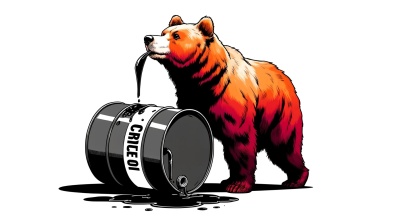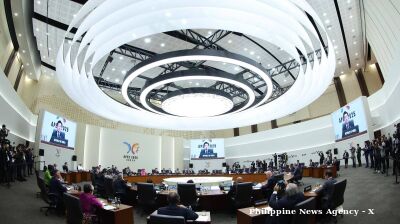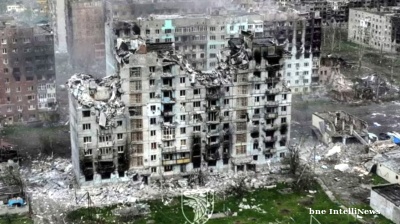Russia evacuates Kursk, moving troops from the front line to retake the region occupied by the Armed Forces of Ukraine

It’s the lull before the storm. The Kremlin has begun a compulsory evacuation of the civilian population from the Kursk region six days after the Armed Forces of Ukraine (AFU) invaded Russia and is redeploying significant numbers of troops from the front line in Donbas. The coming week could see the first major clash as the Kremlin attempts to retake territory in the first occupation of Russian land since WWII.
The incursion started on August 6 and has been the most successful operation since the Kharkiv offensive in September 2022, when the AFU smashed through thinning guarded Russian lines in the Donbas and retook hundreds of square kilometres of territory, routing Russian forces as they went. It also goes a long way to mitigating the disappointment of the failed summer of 2023 counteroffensive when the Ukrainian assault broken on the solid defences that Russia had built up in the subsequent winter following its humiliation during the Kharkiv offensive.
Putin has refused to call the attack an “invasion” or even an “incursion”, referring to it exclusively as a “large-scale provocation” in meetings with his top brass over the weekend.
Ukrainian President Volodymyr Zelenskiy also commented on the offensive for the first time in his nightly address late on Saturday August 10, confirming that Kyiv’s forces are pushing "the war out into the aggressor's territory." The beginning of a Ukrainian surprise attack into Russia was initially reported on August 6.
“We continue the operation!” Commander in Chief Oleksandr Syrskyi told the visibly invigorated Zelenskiy during the briefing on the AFU’s advance.
A clearly irked Putin met with his top brass on August 9 and was told by GGG that the Ukrainian incursion had been stopped when it clearly had not. He reported that 1,000 AFU troops had crossed into Russia, but went on to claim that more than 1,300 had been killed; a statement that was ridiculed even by Russian military bloggers, known as milbloggers.
Russian daily Kommersant, one of Russia’s leading and most independent papers, reported from Kursk, describing scenes of panic and confusion amongst the locals. People feel abandoned, lied to and disillusioned with the government. They harbour hatred for the West, but doubts are creeping in about whether they can actually win this war.
Kommersant correspondent Alexander Chernykh talked to locals that had little idea of what was going on in the first days following the invasion, as the local authorities were thrown into confusion by the surprise attack. Some residents left by car in the first two days, and a few by bicycle, before the Kremlin ordered a mandatory evacuation of 76,000 residents at the weekend, and began to empty the region of civilians before the main force of Russian troops began to attempt to recapture the lost territory.
“I thought we would take them [Ukraine] – but it turns out, they’re taking us,” one resident told Chernykh. “I just want to understand, where is our government? Where is the administration? They could at least talk to us. We know nothing at all. Maybe they don’t know either, but they could at least support us! They could say, “Dear ones, we’re with you…” But there’s no one.”

Russian retaliation
Russian forces have not arrived in strength in the Kursk region and the counterattack is yet to get underway in force; however, the Russian forces retaliated with major rocket attacks on Kyiv, Kherson and Kharkiv over the weekend. Altogether, 11 Ukrainian regions suffered attacks.
Russian forces bombarded Kherson Oblast on 11 August, killing an elderly woman in the city of Kherson and wounding several more in the region. A rocket attack on Kyiv collapsed a building, killing a 35-year-old man and his 4-year-old daughter. And multiple rockets were fired at the border city of Kharkiv.
The Russian foreign ministry said on August 11 Moscow's forces will deliver a "tough response" to Ukraine's surprise incursion into its territory, which included a "massive missile attack" on the border region of Kursk overnight.
The "perpetrators of these crimes ... will be held accountable for them," Foreign Ministry spokesperson Maria Zakharova said in a post on Telegram on August 11. "A tough response from the Russian Armed Forces will not be long in coming," she added.
Ukraine has used its elite 82nd Ukrainian Air Assault Forces that were trained in Germany last year and equipped with Ukraine's best western-supplied weapons to spearhead this attack. They are supported by the 22nd Mechanised Brigade – are also equipped with the best of the Western-supplied armoured vehicles.
Ukraine watcher Igor Sushko, citing the Ukrainian telegram channel Nikolaevsky Vanek, reported on August 10 the Kremlin are bringing in the following Russian units from the front line in Ukraine:
Kherson – 2 paratrooper battalions
Zaporizhia – 38th & 64th Detached Motorised Rifle Brigades
Kupyansk – several battalions from a Motorised Rifle Regiment
Kharkiv – several battalions from 1009th, 79th, 272nd Motorised Rifle Regiments and from 138th Detached Motorised Rifle Brigade
Pokrovske – 810th Detached Motorised Rifle Brigade and several battalions of assault infantry
Luhansk – details unknown
Meanwhile, “Russians are actively bombing Ukrainian soldiers in Sumy across the border in Ukraine and in Russia's Kursk region. Around 50% of all Russian bombing missions across the front have been redirected there. If Ukraine is to succeed, control of the air space is critical,” Sushko said in a social media post.
The extent and strength of Ukraine’s air support is unknown, but it is highly unlikely the newly delivered F-16s will be part of the assault.
AFU dig in, Russian reinforcements on the way
It appears that the AFU is already retreating from its forward positions where it swept through the countryside in the first phase of the attack and is falling back to fewer positions and digging in.
In the initial days the AFU reported took 350 square kilometres of territory but by August 11 it was reported to hold 150 square kilometres, and is building defensive positions in anticipation of a Russian counterattack.

AFU positions in Kursk on the fourth day of the assault, according to open source reporting.
Russia has in the meantime withdrawn multiple units from the front line in the Donbas and is moving them into the Kursk region to launch a counterattack.
In anticipation of a bombardment of the AFU positions, the authorities have rushed to evacuate 76,000 civilians from the region.
The AFU appeared ready to put more pressure on Russian forces with reports of more border incursions in the Belgorod region to the north of Kursk by small Ukrainian units, but not yet in the Bryansk region, the northernmost of the three regions that abut the Ukrainian border. However, there were reports of drone attacks on the agricultural region of Voronezh that lies a little further east and has a short border with Ukraine.
Drones and glide bombs
Ukraine’s forward positions are exposed to Russia’s deadly FAB glide bombs that were introduced earlier this summer, but these bombs – gravity bombs with wings strapped onto them – are only really effective against stationary targets and cannot be used against fast moving highly mobile advancing forces.
The reverse is true for Russian troops. During the winter of 2022, Russia built extensive defences that effectively rebuffed Ukraine’s failed 2023 summer counteroffensive. However, now the Russian reinforcements are on the open road on their way to Kursk, they are exposed to a swarm of Ukrainian drones that have been wreaking havoc on the columns, according to battlefield reports.
In a sign of the extensive planning that has gone into the operation, as bne IntelliNews reported in a feature on the drone war, Russia has had the upper hand in the electronic counter-measures that disable Ukraine’s drones. However, Ukraine has changed the frequencies that all its drones use ahead of this attack, disabling the counter-measures and exposing Russian reinforcements to swarms of drone attacks.
Ukraine’s "Baba Yaga" drone has destroyed Russian fortifications in the Kursk region and can reportedly cause panic amongst Russian troops, according to reports by Russian milbloggers.
Other reports claimed that the Russian 272nd Motorised Rifle Regiment, relocated from the Kharkiv area to near Kursk, came under heavy Ukrainian UAV attacks during its transfer that resulted in several dozen fatalities, and around 100 wounded.
Further back, Ukraine has upped its drone production and Ukrainian President Volodymyr Zelenskiy claimed last week that they are working on the “million drone” programme to become self-sufficient in drones this year. According to Forbes, in July Russia sent 426 Shahed drones to Ukraine. During the same period, Ukraine retaliated with more than 520 drone strikes. The publication also suggests that Russia shoots down UAVs less effectively than Ukraine, now that Kyiv has adjusted its electronic warfare tactics.
Although Russia has more men and superior firepower, it appears that once again Ukraine has used its limited drone force creatively and to great effect and that it is hampering and harrying Russia’s attempts to bring up fresh troops in a counterattack. Despite sending reinforcements, Russian forces are still unable to push back the Ukrainian military in the Kursk region, according to a report with AFU forces in the area by the Financial Times. A Ukrainian soldier stated: "We are going deeper."
Potential talks
Analysts have been speculating about Bankova’s (Ukraine’s equivalent of the Kremlin) military goals in the Battle for Kursk. However, if one of those goals was to force the Kremlin to withdraw troops from the front line in the heavy fighting in the Donbas, then that goal has been achieved. The large-scale redeployment of Russian troops from the front line – at least half a dozen units – will take some pressure off the hard pressed AFU troops currently slowly retreating under the Russian onslaught.
What remains to be seen is if the AFU can hang on to the territory it has captured in the operation and so give Zelenskiy a territorial card to play at the mooted second peace summit planned for November to which both China and Russia have been invited – although neither has yet formally said they will attend.
The head of the Bundestag's defence committee, Marcus Faber, said on social media that Ukraine's offensive in the Kursk region is progressing better than expected and could lay the groundwork for negotiations with Putin's successor.
He noted that Putin no longer has control over the situation.
Kyiv calls on Washington for permission to use Nato missiles on Russian targets
The Pentagon is not worried about escalation due to the events in the Kursk region; Kyiv again asks Washington for permission to use ATACMS in Russian territory.
The Pentagon is not concerned with the possible increase in tensions with the Russian Federation after Ukraine's incursion into the Kursk region, Deputy Pentagon Press Secretary Sabrina Singh said. She emphasized that Ukraine is entitled to do everything possible to continue to reclaim its sovereign territory and the events in the Kursk region fit into this scenario, UBN reports.
"We will continue to support Ukraine with the capabilities and systems it needs. We do not feel that this leads to escalation," Singh said.
She added that Ukraine's advance in the Kursk region is consistent with US policy, although the US continues not to support long-range strikes into Russian territory.
Despite that, Kyiv once again asked Washington to be allowed to strike targets inside Russia with long-range ATACMS missiles. As The Washington Post notes, this would help Ukrainian forces to hold territories in the Kursk region for a certain time. "This will provide the leverage necessary for negotiations with Russia," said an unnamed Zelenskiy adviser.
Analysts say that despite the shock value, Ukraine's progress will likely be short-lived due to Western and domestic pressure, which is expected to force Kyiv to change course.
At the same time, British intelligence has reported that Russian ground forces continue to advance in many areas of the Donetsk front, and that Russia had made tactical progress.
News

US–China soybean sales restart
According to Scott Bessent, US Treasury Secretary, the agreement marks a significant step towards restoring normalcy for American farmers.

Russia faces $50bn annual losses from oil sanctions as Lukoil exits international assets
Russia is expected to lose at least $50bn annually due to oil-related sanctions, as Moscow’s largest private oil producer Lukoil agrees to sell its international assets and Germany considers nationalising operations owned by state-run Rosneft.

Chicken and chips in Seoul - for Nvidia, Samsung and Hyundai
In a low-key fried chicken shop in southern Seoul, the leaders of Nvidia, Samsung Electronics and Hyundai Motor held an informal meeting on the evening of October 30.

Presidents Lee and Xi begin diplomatic chapter at APEC summit
President Lee, who is chairing the first session of the summit at the Hwabaek International Convention Centre, stood at the entrance to personally welcome participants. President Xi reached the venue at approximately 10:02.


